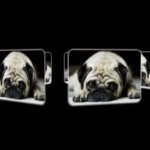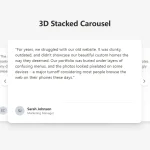| Author: | raulperez0481 |
|---|---|
| Views Total: | 247 views |
| Official Page: | Go to website |
| Last Update: | May 14, 2024 |
| License: | MIT |
Preview:

Description:
This is an interactive image gallery that enables images to rotate manually or automatically in a 3D space.
It was built using vanilla JavaScript and CSS/CSS3. It is ideal for portfolios, product displays, and any web application that needs an eye-catching image presentation.
How to use it:
1. Add images to the gallery container. Each <span> represents an individual image, and the style="--i: [number]" attribute assigns a unique index to each image for positioning purposes.
<div class="image-container">
<span style="--i: 1">
<img src="1.jpg">
</span>
<span style="--i: 2">
<img src="2.jpg">
</span>
<span style="--i: 3">
<img src="3.jpg">
</span>
...
</div>2. Include the next and previous buttons inside the .btn-container element. These buttons allow users to manually control the rotation of the gallery.
<div class="btn-container"> <button class="btn" id="prev">Prev</button> <button class="btn" id="next">Next</button> </div>
3. The required CSS to stablish the 3D perspective, positioning, and styling of the gallery and its components.
.image-container {
width: 200px;
height: 200px;
transform-style: preserve-3d;
transform: perspective(1000px) rotateY(0deg);
transition: transform .7s;
}
.image-container span {
position: absolute;
top: 0;
left: 0;
width: 100%;
transform: rotateY(calc(var(--i) * 90deg)) translateZ(400px);
}
.image-container span img {
position: absolute;
top: 0;
left: 0;
width: 100%;
aspect-ratio: 1/1;
-o-object-fit: cover;
object-fit: cover;
filter: grayscale(100%);
}
.btn-container {
position: relative;
width: 80%;
}
.btn {
position: absolute;
bottom: -140px;
background-color: slateblue;
color: white;
border: none;
padding: 10px 30px;
border-radius: 5px;
cursor: pointer;
font-size: 20px;
}
.btn:hover {
filter: brightness(1.5);
}
.image-container span img:hover {
filter: none;
}
#prev {
left: 20%;
}
#next {
right: 20%;
}4. The JavaScript code powers the core functionality of the gallery:
- It selects essential DOM elements (image container, buttons).
- It initializes variables to track the current rotation degree (
x) and a timer object. - Event listeners are attached to the buttons to update the gallery state (
x) on click. - The
updateGalleryfunction applies the new rotation value to the image container using CSS transforms. It also sets a timer to automatically rotate the gallery periodically.
const imageContainerEl = document.querySelector(".image-container");
const prevEl = document.getElementById("prev");
const nextEl = document.getElementById("next");
let x = 0;
let timer;
prevEl.addEventListener("click", () => {
x += 90;
clearTimeout(timer);
updateGallery();
});
nextEl.addEventListener("click", () => {
x -= 90;
clearTimeout(timer);
updateGallery();
});
function updateGallery() {
imageContainerEl.style.transform = `perspective(1000px) rotateY(${x}deg)`;
timer = setTimeout( () => {
x -= 90;
updateGallery();
}, 3000)
}
updateGallery();









